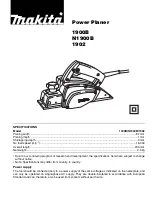
7
20. Check damaged parts.
Before further use of the tool, a guard or other part
that is damaged should be carefully checked to
determine that it will operate properly and perform
its intended function. Check for alignment of moving
parts, free running of moving parts, breakage of
parts, mounting and any other conditions that may
affect its operation. A guard or other part that is
damaged should be properly repaired or replaced by
an authorized service center unless otherwise indi-
cated in this instruction manual. Have defective
switches replaced by an authorized service facility.
Do not use the tool if the switch does not turn it on
and off.
21. Warning.
The use of any accessory or attachment, other than
those recommended in this instruction manual or the
catalog, may present a risk of personal injury.
22. Have your tool repaired by a qualified person.
This electric tool is in accordance with the relevant
safety requirements. Repairs should only be carried
out by qualified persons using original spare parts,
otherwise this may result in considerable danger to
the user.
ADDITIONAL SAFETY RULES
ENB045-2
1.
Rags, cloth, cord, string and the like should
never be left around the work area.
2.
Avoid cutting nails. Inspect for and remove all
nails from the workpiece before operation.
3.
Use only sharp blades. Handle the blades very
carefully.
4.
Be sure the blade installation bolts are securely
tightened before operation.
5.
Hold the tool firmly.
6.
Keep hands away from rotating parts.
7.
Before using the tool on an actual workpiece, let
it run for a while. Watch for vibration or wobbling
that could indicate poor installation or a poorly
balanced blade.
8.
Make sure the blade is not contacting the work-
piece before the switch is turned on.
9.
Wait until the blade attains full speed before cut-
ting.
10. Keep at least 200 mm away from the tool at all
times.
11. Always switch off and wait for the blades to
come to a complete stop before any adjusting.
12. Never stick your finger into the chip chute. Chute
may jam when cutting damp wood. Clean out
chips with a stick.
13. Do not leave the tool running. Operate the tool
only when hand-held.
14. When leaving the planer, switch off and set it
with the front base up on a wooden block, so
that the blades do not contact anything.
15. Always change both blades or covers on the
drum, otherwise the resulting imbalance will
cause vibration and shorten tool life.
16. Wait for complete run-down before putting the
tool aside.
17. Use only Makita blades specified in this manual.
SAVE THESE INSTRUCTIONS.
OPERATING INSTRUCTIONS
Removing or installing planer blades
CAUTION:
Always be sure that the tool is switched off and
unplugged before removing or installing the blade.
For tool with standard planer blades
(Fig. 1, 2 & 3)
To remove the blades on the drum, unscrew the three
installation bolts with the socket wrench. The drum cover
comes off together with the blades.
To install the blades, first clean out all chips or foreign
matter adhering to the drum or blades. Use blades of the
same dimensions and weight, or drum oscillation/vibra-
tion will result, causing poor planing action and, eventu-
ally, tool breakdown.
Place the blade on the gauge base so that the blade
edge is perfectly flush with the inside edge of the gauge
plate. Place the adjusting plate on the blade, then simply
press in the heel of the adjusting plate flush with the back
side of the gauge base and tighten two screws on the
adjusting plate. Now slip the heel of the adjusting plate
into the drum groove, then fit the drum cover on it.
Tighten the three installation bolts evenly and alternately
with the socket wrench.
For tool with mini planer blades (Fig. 1, 4 & 5)
1.
Remove the existing blade, if the tool has been in
use, carefully clean the drum surfaces and the drum
cover. To remove the blades on the drum, unscrew
the three installation bolts with the socket wrench.
The drum cover comes off together with the blades.
2.
To install the blades, loosely attach the adjust plate
to the set plate with the pan head screws and set the
mini planer blade on the gauge base so that the cut-
ting edge of the blade is perfectly flush with the
inside flank of the gauge plate.
3.
Set the adjusting plate/set plate on the gauge base
so that the planer blade locating lugs on the set plate
rest in the mini planer blade groove, then press in
the heel of the adjusting plate flush with the back
side of the gauge base and tighten the pan head
screws.
4.
It is important that the blade sits flush with the inside
flank of the gauge plate, the planer blade locating
lugs sit in the blade groove and the heel of the
adjusting plate is flush with the back side of the
gauge base. Check this alignment carefully to
ensure uniform cutting.
5.
Slip the heel of the adjusting plate into the groove of
the drum.
6.
Set the drum cover over the adjusting plate/set plate
and screw in the three hex flange head bolts so that
a gap exists between the drum and the set plate to
slide the mini planer blade into position. The blade
will be positioned by the planer blade locating lugs
on the set plate.
7.
The blade’s lengthwise adjustment will need to be
manually positioned so that the blade ends are clear
and equidistant from the housing on one side and
the metal bracket on the other.
8.
Tighten the three hex flange head bolts (with the
socket wrench provided) and hand rotate the drum
to check clearances between the blade ends and the
tool body.






























